| C H A P T E R 2 |
|
Installing Servers and Back-End Storage |
Use the procedures in this chapter to install Sun StorageTek 5320 NAS Appliance servers and back-end storage.
This chapter describes the process of installing Sun StorageTek 5320 NAS Appliance servers, controller enclosures, and expansion enclosures. It contains the following sections:
The installation procedures in this chapter require the following items:
Although the system is installed in a single cabinet or rack, the server and the back-end storage units require different rail kits.
Rack requirements to support installation are:
Server rack density varies widely based on systems installed, power distribution installation (in-cabinet, external), power source (single-phase, three-phase), and whether redundant power is required.
For power specifications, refer to Appendix A.
Field installation of the Sun StorageTek 5320 NAS Appliance in the Sun Fire Hardware Expansion Cabinet and third-party ANSI/EIA 310-D-1992 or IEC 60927 compliant cabinets is supported with the slide rail kit (370-7669-02) and cable management arm (370-7668-02).
Hardware Expansion Cabinet and third-party ANSI/EIA 310-D-1992 or IEC 60927 compliant cabinets is supported with the slide rail kit (370-7669-02) and cable management arm (370-7668-02).
The slide rail kit is a 4-point mounted slide rail kit and is designed to enable the Sun StorageTek 5320 NAS Appliance to be racked in the Sun Rack 900, the Sun Rack 1000, and third-party ANSI/EIA 310-D-1992 or IEC 60927 compliant racks. No other kits are available to allow 2-point, front-mount, or mid-mount configuration.
Rack 900, the Sun Rack 1000, and third-party ANSI/EIA 310-D-1992 or IEC 60927 compliant racks. No other kits are available to allow 2-point, front-mount, or mid-mount configuration.
The slide kit includes hardware that enables mounting to any of the following types of rack rails:
Use the following procedures to prepare for installation:
Before you begin rackmounting, do the following:

|
Caution - Uneven loading of the rack can cause dangerous instability. |
You must maintain reliable grounding of this equipment. Review specifications in Appendix A to determine the appropriate AC branch circuit size for the quantity of units in your configuration and your operating voltage. Always follow your local electrical codes for loading circuits.
1. For each controller enclosure and expansion enclosure, make sure that the power switch is turned off and that both power cables are plugged in.
2. Wear a wrist strap, and always be properly grounded when touching static-sensitive equipment or parts.
If a wrist strap is not available, touch any unpainted metal surface on the back panel of any unit to dissipate static electricity. Repeat this procedure several times during installation.
3. Avoid touching exposed circuitry, and handle components by their edges only.

|
Caution - Do not power on any units until after you have connected the Sun StorageTek 5320 NAS Appliance to the network. |
1. Include a third-wire safety ground conductor with the rack installation to avoid the potential for an electrical shock hazard.
2. Use a minimum 14 AWG connected to the earth ground stud on the back of the server.
3. Connect the safety ground conductor to the chassis stud with a two-hole crimp terminal with a maximum width of 0.25 inch.
4. Install the nuts on the chassis with a 10 in/lb torque.
The safe ground conductor provides proper grounding only for the Sun StorageTek 5320 NAS Appliance. You must provide additional proper grounding for the rack and other devices installed in it.
Review specifications in Appendix A to determine isolation and continuous power requirements.
You are responsible for installing an AC power disconnect for the entire rack unit. This power source disconnect must be readily accessible, and it must be labeled as controlling power to the entire rack unit, not only to the servers.
|
 Ensure that you have all of the parts in the rackmount kit before you begin the installation of the server:
Ensure that you have all of the parts in the rackmount kit before you begin the installation of the server:
The rackmount kit contains two slide rail assemblies. A slide rail assembly can be installed on either the right or left side of the rack.
A slide rail assembly consists of two parts: a slide rail and a removable mounting bracket. The slide rail attaches to the rack posts. The mounting bracket attaches to the server chassis.
|
2. Check the contents of the box for the following items:
3. Be sure you have the power cords (two per server), which were shipped separately.
|
|
Note - For NAS head installation, refer to the Sun LX50/Sun Fire V60x/Sun Fire V65x rail-mounting kit rail kit instructions. |
Unpack the rackmount kit and check the contents. The CAM100 3RU rail kit contains the following items:
The rails can be adjusted to fit the cabinets.
|
2. Check the contents of the box for the following items:
|
Select the cabinet in which you will be installing the Sun StorageTek 5320 NAS Appliance. Be sure the cabinet is installed as described in the installation instructions provided with it.
1. Stabilize the cabinet as described in the cabinet documentation.
2. If the cabinet has casters, make sure the casters are locked to prevent the cabinet from rolling.
3. Remove or open the top front panel.
4. Remove or open the vented back panel.
You must plan your installation carefully.
The controller and expansion enclosures must be installed in the cabinet as follows, always starting from the bottom up. Starting at the bottom distributes the weight correctly in the cabinet.
FIGURE 2-1 shows the cabinet with a single controller enclosure, single expansion unit, room for additional storage, and single server installed at the top.
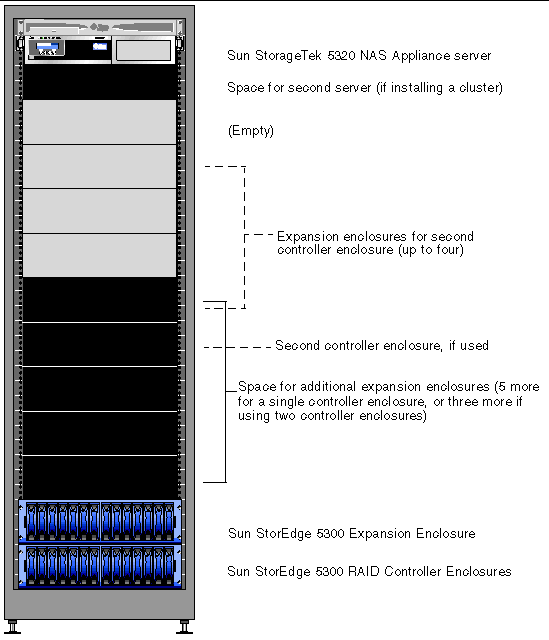
|
1. Mount the controller enclosure in the bottom of the cabinet.
2. Mount any expansion enclosures (maximum six) from the bottom up.
The first expansion enclosure above the controller enclosure is EU 1, then EU 2, and so on.
3. Mount the Sun StorageTek 5320 NAS Appliance in the top of the cabinet.
If you are installing a cluster, install the servers as follows:
a. Sun StorageTek 5320 NAS Appliance server H1 (software serial number ending "-H1") at the top.
The software serial number is located at the front of the server, below the LCD display. It is also printed on the Customer Information Sheet (CIS).
b. Sun StorageTek 5320 NAS Appliance server H2 (software serial number ending "-H2") below server H1.
|
1. Mount the controller enclosure in the bottom of the cabinet.
2. Mount any expansion enclosures (maximum four) from the bottom up, and be sure to leave space for the maximum four EUs if you do not install them at this time.
The first expansion enclosure above the controller enclosure is EU 1, then EU 2, and so on.
3. Mount the second controller enclosure.
4. Mount any expansion enclosures (maximum four) for the second controller enclosure, and be sure to leave space for the maximum four expansion enclosures if you do not install them at this time.
5. Mount the Sun StorageTek 5320 NAS Appliance in the top of the cabinet.
If you are installing a cluster, install the servers as follows:
a. Sun StorageTek 5320 NAS Appliance server H1 (software serial number ending "-H1") at the top.
The software serial number is located at the front of the server, below the LCD display. It is also printed on the Customer Information Sheet (CIS).
b. Sun StorageTek 5320 NAS Appliance server H2 (software serial number ending "-H2") below server H1.
The CAM100 3RU rails must be used to install the enclosures.
|
Note - For NAS head installation, refer to the Sun LX50/SunFire V60x/SunFire V65x rail-mounting kit instructions. |
Use the following procedure to attach the rails to a Sun Rack 900 or Sun Rack 1000 cabinet. Because this rail kit can be adapted for several cabinets, closely follow the procedures; they may require actions that you have not previously taken.
|
Note - In this section, you will loosely hang the rails from screws you attach to the side walls before connecting the rails to the front and back. |
|
1. Using the No. 2 Phillips screwdriver, loosen the side-rail screws and adjust each rail to its maximum length (FIGURE 2-2).
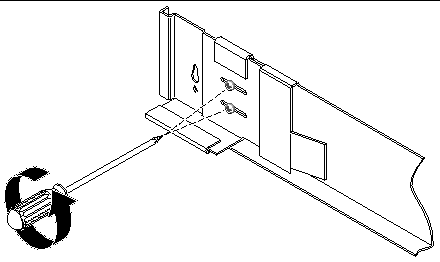
2. Locate the proper mounting holes by placing the rack alignment template for the Sun Rack 900/1000 cabinet over the front left cabinet rail (FIGURE 2-3).
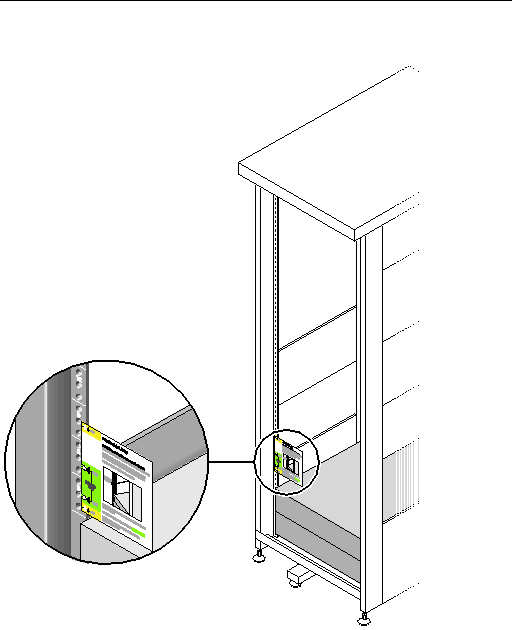
3. Slide the template up and down until all four holes line up with the cabinet rail holes.
4. Note the screw hole numbers of the two mounting holes.
You will use the same screw hole numbers for the rest of this installation.
5. Using the No. 2 Phillips screwdriver, insert and tighten two 8-32 screws to secure the the left rail to the front of the cabinet (FIGURE 2-4). Repeat for the right rail.

6. At the back of the cabinet, adjust the length of each rail as needed to fit the cabinet, and position the rail flange over the vertical rail (FIGURE 2-5).

7. Using the No. 3 Phillips screwdriver, insert and tighten the M6 screws on each side at the back of the rail (FIGURE 2-6).
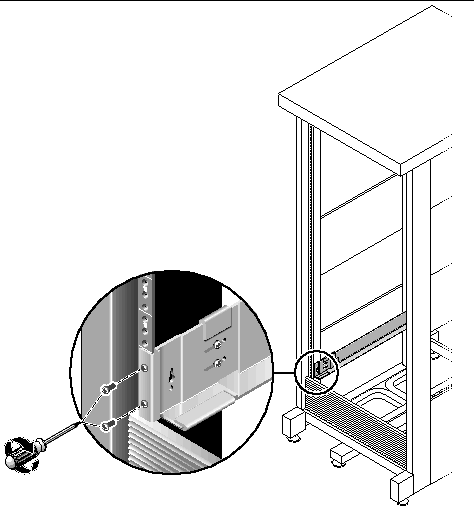
8. Using the No. 2 Phillips screwdriver, tighten the four adjusting screws (two on each side) toward the back of each rail (FIGURE 2-7).

If you are installing expansion enclosures, install the first one in the first empty slot at the bottom of the cabinet, and continue installing any additional expansion enclosures from the bottom up, followed by the controller enclosure. For information about order of enclosure installation, refer to Installing in the Cabinet.
After installing each enclosure, you must connect its power cables and set the tray ID as described in Setting the Tray ID.
|
1. Unsnap and remove the left and right end caps on the enclosure to permit access to the screw mounting holes (FIGURE 2-8).

2. Using two people, one at each side of the enclosure, carefully lift and rest the enclosure on the bottom ledge of the left and right rails (FIGURE 2-9).

|
Caution - Use care to avoid injury. An enclosure can weigh up to 95 pounds
|
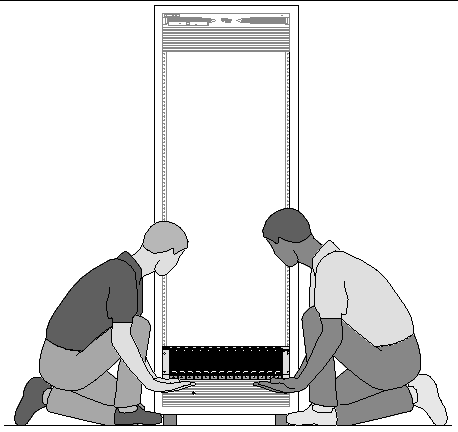
3. Carefully slide the enclosure into the cabinet until the front flanges of the enclosure touch the vertical face of the cabinet (FIGURE 2-10).
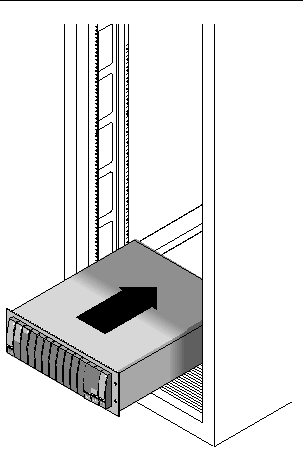
4. Depending on the type of cabinet you have, do one of the following:
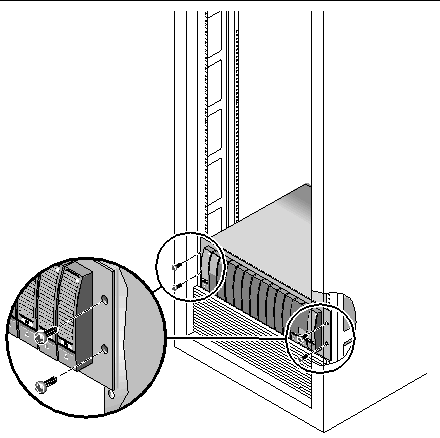
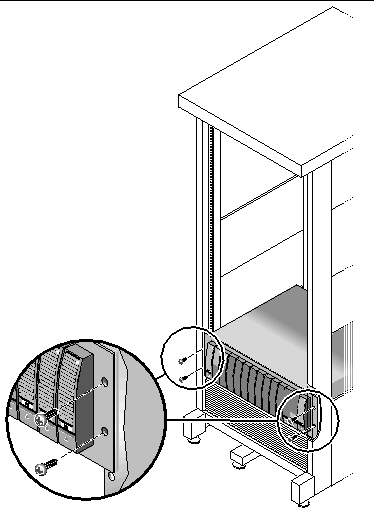
5. Replace the left and right end caps to hide the front mounting screws.
The end caps snap onto the front bezel of the tray.
6. At the back of the enclosure, install and tighten two 8-32 screws (one per side) to secure the back of the enclosure to the cabinet (FIGURE 2-13).

Installing a server involves three steps:
1. Installing the slide rails (refer to To Install the Slide Rail Assemblies)
2. Installing the cable management kit (refer to To Install the Cable Management Kit)
3. Verifying the operation of the slide rails and cable management (refer to To Verify the Operation of the Slide Rails and the CMA)
1. Pull both mounting brackets completely out of their respective slide rails:
a. Simultaneously press and hold the upper and lower lock buttons of the slide rail lock (FIGURE 2-14).

b. Pull the mounting bracket out until it locks in the extended position.
c. Slide the mounting bracket release button in the direction shown in FIGURE 2-15, and then slide the mounting bracket out of the slide rail.

d. Press the metal lever (labeled Push) on the middle section (FIGURE 2-16) of the sliding rail, and then push the middle section back into the rack.
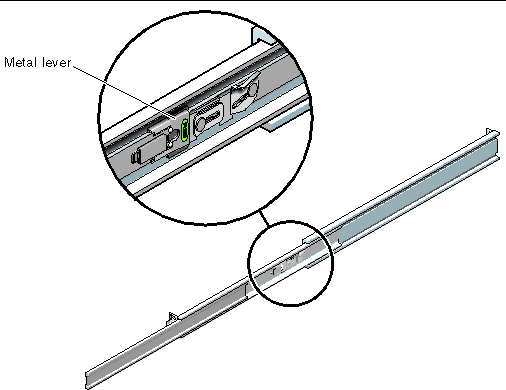
2. Attach a mounting bracket to the right side of the server chassis.
a. Position the mounting bracket against the server chassis (FIGURE 2-17) so that the slide rail lock is at the front and the three keyed openings on the mounting bracket are aligned with the three locating pins on the side of the chassis.

b. With the heads of the three locating pins protruding though the three keyed openings in the mounting bracket, pull the mounting bracket toward the front of the chassis until the bracket locks into place with an audible click.
c. Verify that all three locating pins are trapped in the keyed openings and that the back locating pin has engaged the mounting bracket lock, as shown in the right side of FIGURE 2-17.
3. Attach the second mounting bracket to the left side of the server chassis.
4. Determine which rack hole numbers to use when attaching the slide rails to the rack posts.
The server is two rack units tall (2U). The slide rails will occupy the lower half of the 2U space.
5. Determine which screws you will use to mount the slide rails.
If your rack has threaded mounting holes in the rack posts, determine whether the threads are metric or standard. Select the appropriate screws from the package included in the mounting kit.
If your rack does not have threaded mounting holes, the mounting screws are secured with a caged nut.
6. Attach a slide rail to the right front rack post.
a. Loosely attach the front of a slide rail to the right front rack post (FIGURE 2-18) using two screws.
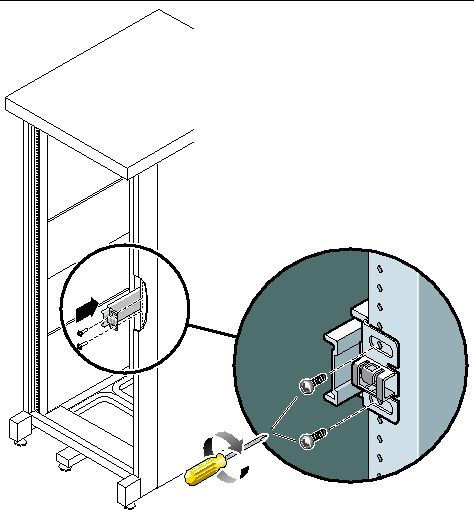
b. Adjust the length of the slide rail by sliding the back mounting flange to reach the outside edge of the back rack post.
c. Loosely attach the back of the slide rail to the back rack post with two screws.
7. Attach the second slide rail to the left rack posts in a similar manner. Again, do not tighten the screws.
8. Use the slide rail spacing tool to adjust the distance between the slide rails:
a. At the front of the rack, plug the left side of the tool into slots at the end of the left rail (FIGURE 2-19).
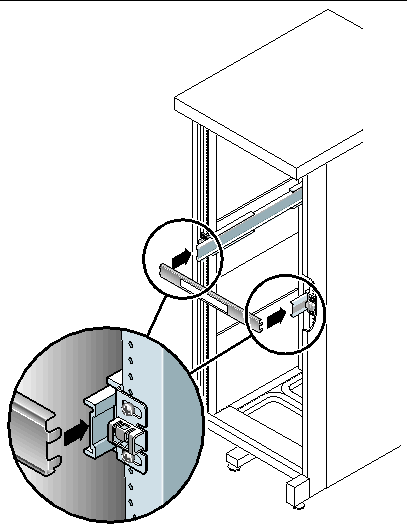
b. Insert the right side of the tool into the front end of the right rail, while sliding the end of the rail to the right or left as needed to allow the ends of the tool to enter the ends of both rails.
The distance between the rails is now equal to the width of the server with mounting brackets.
c. Tighten the screws to lock the ends of the rails in place.
d. At the back of the rack, repeat Step a through Step c for the back ends of the rails.
9. Deploy the anti-tilt bar, if the chassis or rack is so equipped.

|
Caution - The weight of the server on extended slide rails can be enough to overturn a cabinet. |
10. Insert the ends of the mounting brackets into the sliding rails (FIGURE 2-20).

|
Caution - The server weighs approximately 52 pounds (24 kg). Two people are required to lift and mount the system into a rack enclosure when using the procedures in this chapter. |
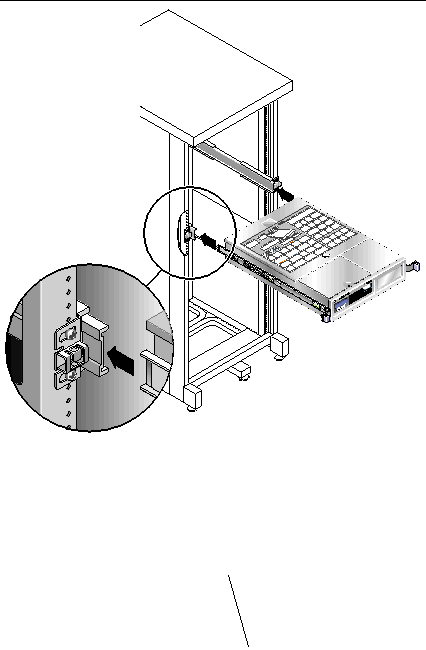
11. Simultaneously release the rail locks on each side of the sliding rails, and guide the chassis into the rack.

|
Caution - Verify that the server is securely mounted in the rack, and that the slide rails are locked to the mounting brackets, before continuing. |
The cable management assembly (CMA) clips into the ends of the left and right sliding rail assemblies. No screws are necessary for mounting the CMA.

|
Caution - Support the CMA during this installation. Do not allow the assembly to hang by its own weight until it is secured by all three attachment points. |
1. At the back of the rack, plug the CMA rail extension into the end of the left sliding rail assembly (FIGURE 2-21).
The tab at the front of the rail extension clicks into place.
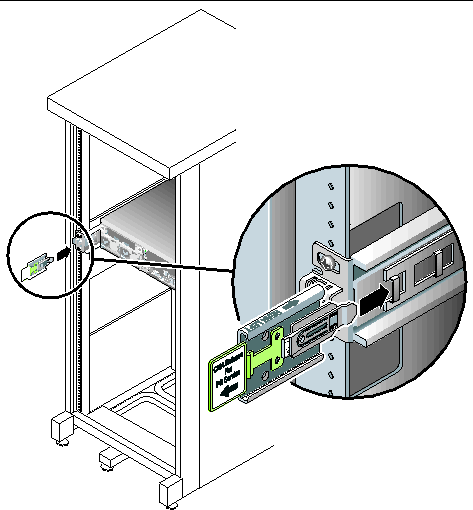
The right sides of the two CMA arms have hinged extensions. On the manufacturer's instruction sheet, the smaller extension is called the CMA Connector for Inner Member. It attaches to the right mounting bracket. The larger extension is called the CMA Connector for Outer Member, and attaches to the right sliding rail.
2. Insert the smaller extension into the clip located at the end of the mounting bracket (FIGURE 2-22).
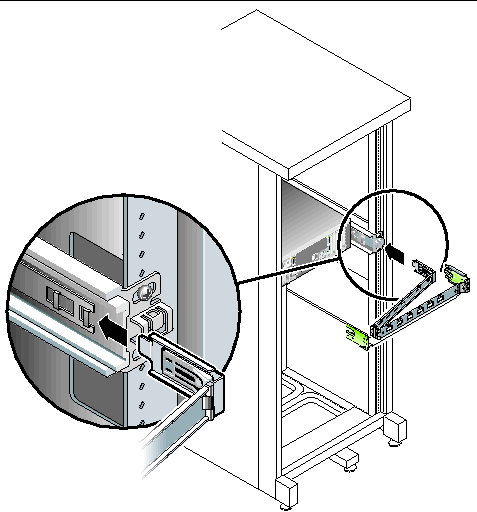
3. Insert the larger extension into the end of the right sliding rail (FIGURE 2-23).

4. Insert the hinged plastic connector at the left side of the CMA fully into the CMA rail extension (FIGURE 2-24).
The plastic tab on the CMA rail extension locks the hinged plastic connector in place.
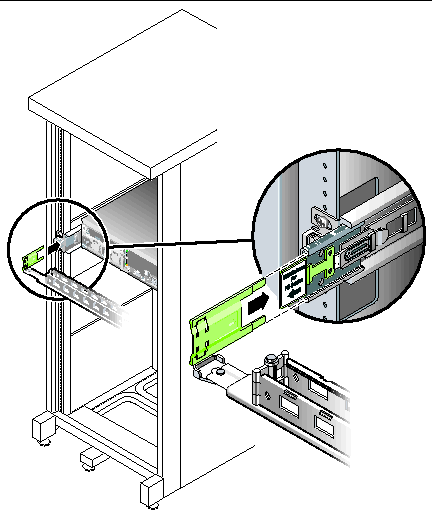
|
Tip - Two people are needed for this procedure: one to move the server in and out of the rack and one to observe the cables and CMA. |
1. For a cabinet or a free-standing rack, deploy the anti-tilt bar.
2. Unlock the slide lock buttons (FIGURE 2-25) at the right and left sides of the server chassis, and slowly pull the server out of the rack until the slide rails reach their stops.

3. Inspect the attached cables for any binding or kinks.
4. Verify that the CMA extends fully and does not bind in the slide rails.
5. When the server is fully extended out, release the slide rail lever stops (FIGURE 2-26).
Push both levers simultaneously and slide the server back into the rack.
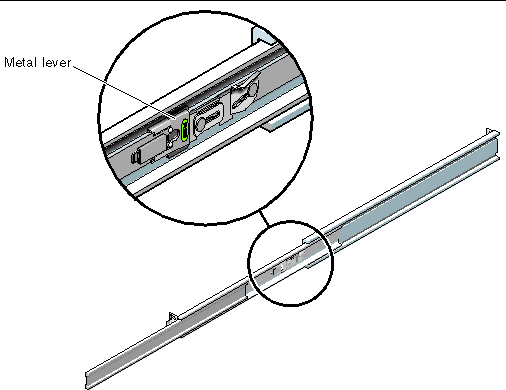
6. Simultaneously unlock both slide rail release buttons (FIGURE 2-27), and push the server completely into the rack.

The server should stop after approximately 15 inches (40 cm) of travel.
7. Verify that the cables and the CMA retracted without binding.
8. Adjust the cable hangers and CMA as required.
1. Verify that both power switches are off for each controller enclosure and expansion enclosure in the cabinet.
2. Connect each power supply in each unit to a separate power source in the cabinet.

|
Caution - The cabinet must have two power sources connected to two separate power circuits. |
3. Connect each power supply in the Sun StorageTek 5320 NAS Appliance to a separate power source in the cabinet.
After connecting the server power cords to the power source, the Power/OK LED flashes indicating standby power mode.
4. Connect the primary power cables from the cabinet to the external power source.
|
Note - Do not power on the units until you complete the installation procedures for your system. The power-on sequence is described in detail in Powering On the Sun StorageTek 5320 NAS Appliance, Controller Enclosures, and Expansion Enclosures. |
You set the tray ID using the Tray ID switch at the back of the expansion enclosures and controller enclosures. You must set the tray ID of each enclosure to a unique number from 00 to 77.
1. Locate the Tray ID switch at the back of the controller enclosure, between the two power supplies (FIGURE 2-28).

2. Use a pen tip to press the plus and minus buttons on the X10 and X1 switch to the appropriate setting.
The X10 switch at the left sets the tens place of the tray ID, and the X1 switch sets the ones place. For example, to set the tray ID to 11, set the X10 switch to 1 and the X1 switch to 1.
By convention, tray ID 00 refers to the controller enclosure. The first expansion enclosure located above the controller enclosure is tray ID 01. The second expansion enclosure is tray ID 02. The tray ID increments by 01 for each expansion enclosure installed in the cabinet.
When you have finished installing all units and servers and connected their power cables, you are ready to connect the servers to the controller units and the controller units to the (optional) expansion units as described in subsequent chapters.
Use the chapter appropriate to the system that you are setting up.
|
Single-server Sun StorageTek 5320 NAS Appliance to back-end storage |
|
|
Dual-server Sun StorageTek 5320 NAS Cluster Appliance to back-end storage |
|
Copyright © 2006, Sun Microsystems, Inc. All Rights Reserved.